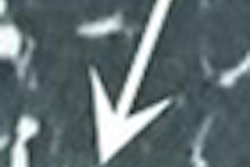Adaptive statistical iterative reconstruction (ASIR) technology can not only reduce CT radiation dose and improve image quality, it can also improve the sensitivity of computer-aided detection (CAD) software for detecting pulmonary nodules, according to researchers from Osaka University Medical School in Osaka, Japan.
In a prospective study, the research team found that applying CAD to CT data processed with ASIR reconstruction yielded significantly higher CAD sensitivity than CAD applied to conventional CT data. The difference was witnessed for overall nodules -- and, in particular, for ground-glass opacity (GGO) nodules -- on both standard and low-dose CT studies. However, the improved sensitivity for small and faint nodules such as GGO did come with significantly higher false positives.
"ASIR has the potential to improve the performance of CAD," said Masahiro Yanagawa, MD, PhD. He presented the research during a scientific session at the 2010 RSNA meeting in Chicago.
Because MDCT scanners with garnet detectors can improve spatial resolution and ASIR can improve image quality by decreasing image noise, the researchers hypothesized that these technologies together might influence the performance of CAD in detecting pulmonary nodules, Yanagawa said.
To evaluate the effect of ASIR on CAD in both standard and low-dose CT, the researchers prospectively studied 35 patients (18 men and 17 women) with existing or clinically suspicious pulmonary nodules. The patients had a mean age of 64.6 years.
Chest CT data were acquired at standard dose (120 kVp with automatically adjusted tube current) and low dose (120 kVp, 100 mA) on a Discovery CT750 HD 64-slice MDCT scanner (GE Healthcare, Chalfont St. Giles, U.K.).
The scanner's high-resolution scan mode with 2,496 views per rotation was utilized, according to the researchers. Each 0.625-mm thick image was then reconstructed at 0%, 50%, and 100% levels of ASIR processing.
To create the reference standard for the study, two independent chest radiologists (with nine years and 18 years of experience, respectively) read the entire set of images without ASIR on standard-dose CT. A consensus panel then classified all of the candidate lesions as either true-positive or false-positive findings.
They found 265 noncalcified nodules with a diameter of ≤ 30 mm, including 103 ground-glass opacity nodules, 34 part-solid nodules, and 128 solid nodules. The nodules had a mean diameter of 4.37 mm ± 3.16 mm.
CAD was then applied using the Lung VCAR software on GE's Advantage Workstation 4.2. The CAD results were retrospectively assessed in comparison with the reference standard results.
CAD sensitivity for overall nodules
|
"The sensitivity of CAD at 0% ASIR on standard-dose CT is almost equal to that of 100% ASIR on low-dose CT," Yanagawa said.
The differences in sensitivity between the levels of ASIR were statistically significant (p < 0.001).
"The sensitivity of overall [nodules] increases significantly with increasing degree of ASIR, on both standard-dose CT and low-dose CT," he said. "In particular, sensitivity of GGO on standard dose and sensitivity of solid [nodules] on low dose increased significantly with increasing degree of ASIR."
CAD sensitivity by nodule type
|
The differences in sensitivity for GGO by ASIR type were statistically significant (p < 0.001).
Mean false-positive findings per exam
|
The increases in false-positive findings by ASIR type were statistically significant (p < 0.001).
"ASIR is one of the techniques that can increase the sensitivity of CAD despite increasing false-positive findings," Yanagawa concluded.
By Erik L. Ridley
AuntMinnie.com staff writer
January 12, 2011
Related Reading
CAD may boost CT detection of pulmonary embolism, January 11, 2011
Bundling of CAD software boosts lung lesion detection at CT, September 21, 2010
ASIR enables big CT dose reductions in the abdomen, September 15, 2010
Better images are next frontier for CT iterative recon, August 30, 2010
MBIR aims to outshine ASIR for sharpness, CT dose reduction, May 18, 2010
Copyright © 2011 AuntMinnie.com





















